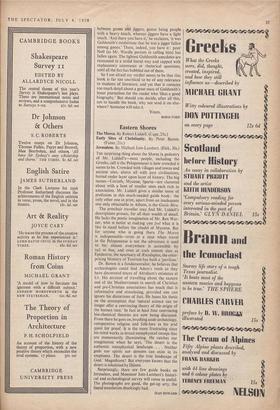Eastern Shores
The Morea. By Robert Liddell. (Cape, 25s.) Early Sites of Christianity. By Peter Bamm. (Faber, 21s.)
Jerusalem. By Michael Join-Lambert. (Elek, 30s.) THE surprising thing about the Morea (a pedantry of Mr. Liddell's—most people, including the Greeks, call it the Peloponnese) is how crowded it seems to be. Crowded with villages and towns and ancient sites, above all with past civilisations, buried under layer upon layer of history. The big names—Corinth, Mycenw, Sparta—are clustered about with a host of smaller ones each rich in association. Mr. Liddell gives a similar sense of profusion in this much-needed guide book : the only other one in print, apart from an inadequate one only obtainable in Athens, is the Guide Bleu.
The armchair traveller may find Mr. Liddell's descriptions prosaic, for all their wealth of detail. He lacks the poetic imagination of Mr. Rex War- ner, who is better at making you feel what it is like Co stand before the citadel of Mycente. But for anyone who is going there The Morea is indispensable—even at a time when travel in the Peloponnese is not the adventure it used to be; almost everywhere is accessible by rail or bus, and even at such remote sites as Epidaurus, the sanctuary of yEsculapius, the enter- prising Ministry of Tourism has built a `pavilion.'
Dr. Bamm is a fundamentalist; he believes that archmologists could find Adam's tomb as they have discovered traces of Abraham's existence at Ur. His account of travelling about the eastern end of the Mediterranean in search of Christian and pre-Christian associations has much that is informative and stimulating, provided one can ignore his distortions of fact. He bases his thesis on the assumption that `natural science can no longer offer a convincing theory of the origin of the human race.' In fact at least four convincing bio-chemical theories are now being discussed. From there he goes on, brushing aside archeology, comparative religion and folk-lore in his arid quest for proof. It is the more frustrating since his mind works in broad metaphysical sweeps that are momentarily illuminating. He catches our imagination when he says, `The desert is the authentic metaphysical landscape. . . . Neither gods nor spirits nor demons can exist in its emptiness. The desert is the true landscape of God.' Magnificent! But everyone knows that the desert is inhabited by Djinns.
Surprisingly, there are few guide books on Jerusalem, and Monsieur Join-Lambert's histori- cal and archmological survey will come in useful. The photographs are good, the get-up arty, the literal translation shockingly bad.
JEAN HOWARD






















































 Previous page
Previous page